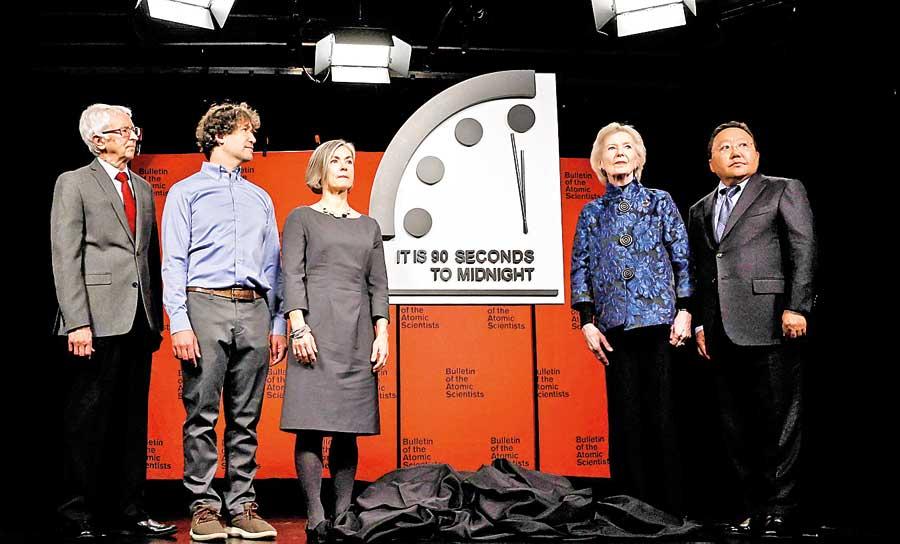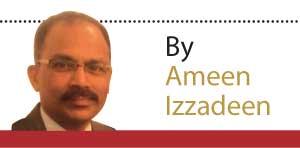27 Jan 2023 - {{hitsCtrl.values.hits}}

Bulletin scientists Siegfried S. Hecker, Daniel Holz, Sharon Squassoni, Mary Robinson and Elbegorj Tsakhia stand for a photo with the 2023 Doomsday Clock. AFP
A dangerously close 90 seconds to midnight may not be an adequate warning from the world’s renowned scientists who annually determine the time left for a global catastrophe, about which world leaders pay little or no attention.
which world leaders pay little or no attention.
Just as the 2004 tsunami and the 2020 Covid pandemic visited us uninvited and unannounced, a nuclear catastrophe will also hit us all of a sudden. With the Ukraine war seeing escalation after escalation, a nuclear calamity is nearer than ever.
Until it happens and until the few unlucky survivors suffer its horrifying consequences, the gravity of a nuclear holocaust cannot be fathomed. Even the survivors of the 1946 atomic bomb attacks on Hiroshima and Nagasaki, if there are any, may see the horror they underwent as nothing more than a pinprick when compared to the devastation a modern-day nuclear war will unleash.
On Tuesday, January 24, the 90-second-to-midnight warning came from the Bulletin of Atomic Scientists, a nonprofit organization concerning science and global security issues resulting from accelerating technological advances that have negative consequences for humanity.
It came against the backdrop of the continuing flare-up in the Ukraine-Russia war and the lack of cooperation by the world’s biggest polluters, including the war-mongering industrialized West, to deal with climate change.
“The Doomsday Clock was set at 90 seconds to midnight, due largely but not exclusively to Russia’s invasion of Ukraine and the increased risk of nuclear escalation. The new Clock time was also influenced by continuing threats posed by the climate crisis and the breakdown of global norms and institutions needed to mitigate risks associated with advancing technologies and biological threats such as COVID-19,” the Bulletin said in a statement.
The iconic Clock’s original setting in 1947 was seven minutes to midnight. It has since been set backward eight times and forward 17 times, the farthest from midnight being 17 minutes in 1991 – the year in which the cold war ended -- and the nearest being 90 seconds, set on this Tuesday.
Describing the state of the world today as “unprecedented danger,” the Bulletin’s president and CEO Rachel Bronson said the scientists were not taking the warning lightly.
“The US government, its NATO allies and Ukraine have a multitude of channels for dialogue; we urge leaders to explore all of them to their fullest ability to turn back the Clock,” she said.
But the US and its NATO allies do not seem to be in the mood to heed the 90-second warning. On the contrary, the Western leaders upped the ante this week with the United States and finally a hitherto-reluctant Germany deciding to send advanced battle tanks to Ukraine.
Surprisingly, it was the Green Party that was the biggest pusher behind German Chancellor Olaf Scholz’s decision to relax his position of not sending the Leopard tanks to the Ukrainian front. Once thought to be pacifists, the Greens now appear to be swerving from their objectives aimed at achieving ecological wisdom, social justice, participatory democracy, nonviolence, sustainability and respect for diversity.
Germany’s Foreign Minister and Green Party stalwart Annalena Baerbock is reported to have admitted that the war is not between Ukraine and Russia but with the European Union and Russia. “We are fighting a war against Russia and not against each other,” she said during a debate on sending the tanks at the Parliamentary Assembly of the Council of Europe.
Germany’s eventual decision to send the world’s most sophisticated battle tanks to Ukraine is a major shift from the avowed “Never Again” tenet Berlin has been maintaining since it emerged as a rehabilitated nation from the crimes of World War II.
Needless to say, the German decision will only escalate the war. The Russian bear will not run away from the battlefield with its tail between its legs when the German leopards roar for the Ukrainian army.
Moscow has slammed Berlin’s move to supply Ukraine with battle tanks and accused Germany of abandoning its “historical responsibility to Russia” arising from Nazi crimes in World War II.
In Germany, the Russian embassy said Berlin’s decision would lead to “permanent escalation” of the war.
During World War II, the Germans sent 3000 tanks to the Russian front, only to suffer a costly defeat. So this time, the Germans are sending only 14 Leopards. The US is planning to send 31 Abrams tanks which were used in military operations in Afghanistan and Iraq. It is debatable whether these tanks played a game-changer role in the Afghan and Iraqi wars.
The Russians say they have their plans. Russian President Vladimir Putin has issued thinly veiled threats of the possibility of tactical nuclear weapons being used if the push comes to a shove.
In recent weeks, Russia has been making ground on the battlefield, though analysts say Russia is not winning enough and Ukraine is not losing enough.
The West believes that, by arming Ukraine, it can force the Russians to the negotiating table. Russia is unlikely to accept a truce on Ukraine’s or the West’s terms. The conditions entail the payment of war reparations running into hundreds of billions of dollars and the return of all Russian-annexed territories, including Crimea.
Besides, such a humiliating surrender could spell disaster for Russia right around it and within. Georgia, which is smarting over Russia’s high-handed action of carving out two separate states from its territory, may resume the war to take back lost territories and even join NATO.
Central Asian states may drift away from a militarily emaciated Russia and strengthen their ties with the US and the West.
Within Russia, separatist tendencies in Chechnya, Dagestan, and other regions may be kindled by the victorious West to further weaken Russia or keep Putin militarily occupied inside the country, instead of outside.
Certainly, a nuclear-powered Russia would not want to be a Mr. Nothing -- or Ser Nihilo as Niccolo Machiavelli would say – among the nations. If the war escalates to a point where defeat will stare at the Russian president’s face, the use of nuclear weapons is a bigger possibility.
Russia is estimated to have around 2,000 tactical warheads which can be fitted into missiles. These tactical nuclear arms are smaller -- both in size and explosive power -- designed for use in a battlefield or in a theatre of operations. In such an eventuality, the possibility of which is dangerously closer now than ever, will the West send its tactical nuclear weapons to Ukraine, just as it is sending its advanced tanks? Then, prepare for the nuclear holocaust.
This week’s peace-crushing moves also come amidst concern over the 2016 expiry of the US-Russia Strategic Arms Reduction Treaty (START), with neither country showing any interest to extend it.
Former Irish President and former UN Human Rights High Commissioner Mary Robinson, said on Tuesday, “The Doomsday Clock is sounding an alarm for the whole of humanity. We are on the brink of a precipice. But our leaders are not acting at sufficient speed or scale to secure a peaceful and liveable planet.”
08 Jan 2025 26 minute ago
08 Jan 2025 1 hours ago
08 Jan 2025 3 hours ago
08 Jan 2025 4 hours ago